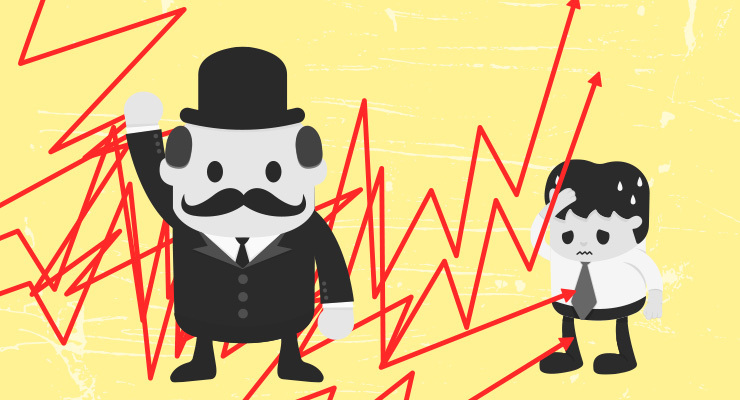
Australia’s peer nations are all grappling with higher-than-expected inflation. It recently hit a 40-year high in the US (7.5%), and 30-year highs in New Zealand (5.9%), the UK (5.5%) and Canada (5.1%).
Australia’s uptick has been comparably smaller (3.5%). Yet some are understandably asking whether we’re simply a few steps behind, and if greater price rises are in store. The Morrison government seems to think so, with MPs expressing concerns that extending low- and middle-income tax cuts could fuel more inflation.
They’re right to watch carefully, for prolonged high inflation can be a serious problem. But some commentators are straying into hysterical or opportunistic territory, pre-emptively urging the Reserve Bank to raise interest rates and the government to cut spending to stave off the mere possibility of higher prices. This replicates a long-held pattern — whenever they smell a mere whiff of inflation, conservative commentators prematurely call for it to be crushed.
Why should you care? Because the methods they use will often lower your wages, limit your job opportunities and increase inequality.
Inflation wars are class wars
The standard inflation-busters that “hawks” call for are interest rate hikes, government spending cuts and wage restraint. In the UK, for instance, rates have been raised twice this year, debate has arisen in Downing Street over spending restraint, and the Bank of England’s governor has attracted ridicule for asking workers not to push for pay raises while raking in huge sums himself.
It’s unsurprising that rich bankers worry excessively about inflation — it reduces the relative size of their stockpile. One’s bank account isn’t indexed, so when prices go up, the value of one’s savings falls.
But for the rest of us the medicine can be worse than the disease. Interest rate hikes increase the cost of borrowing. This doesn’t just hit mortgage holders — debt finances much business expansion, so it limits the number of jobs on offer too.
Similarly, cuts to public spending often lower welfare recipients’ incomes and kick public servants out of jobs. Unemployed people thus have lower incomes and fewer chances to find work, workers have fewer opportunities to trade in crappy jobs for better ones, and businesses face less pressure to offer employees good conditions to stem staff turnover.
Inflation hawks rarely spell this out, but they’re usually asking the authorities to prop up their fortunes by keeping the working class in their place; to reduce the price of things by reducing the ability of the lower and middle classes to buy those things. As Lord Farquaad said in Shrek, “Some of you may die, but that’s a sacrifice I’m willing to make.”
This came into sharpest relief in the 1970s when various politicians and bureaucrats used the crudest possible methods to break inflationary spirals, pushing millions on to dole queues and entrenching a low-wage paradigm for decades.
In 2022 there are other inflation-busters we should try first, particularly clearing supply-chain bottlenecks, which COVID has multiplied, and smoothing shifts in purchases from services to goods (when COVID cases spike, many substitute events and travel for clothes and electronics).
If things are growing desperate, blunter instruments might need to be used, but only with restraint and recognition of the human costs.
In Australia, we’re nowhere near needing them. We’ve only just achieved a “hot” jobs market, workers have barely seen wage growth, and prices have only risen modestly.
Bidenomics is a welcome reprieve
The Biden administration and US Federal Reserve have most ambitiously broken with the inflation hawks, keeping interest rates low and pushing through big infrastructure and welfare bills.
“Instead of workers competing with each other for jobs that are scarce, we want employers to compete with each other to attract work,” Biden said in May.
He achieved this goal, raising employment and wages significantly and improving social outcomes. Until rogue Democrats scuttled transformative child payments, US child poverty was on track to nearly halve.
Biden could’ve pushed even further, but a sclerotic Congress concentrated his spending in shorter bursts, which may have poured fuel on COVID-related inflationary pressures. Officials are likely to have to smooth out stimulus from now on.
But his achievements should be instructive. Some had previously wondered whether the global economy had simply entered a period of lower wages and growth, perhaps due to some immutable factor like technology. Some prominent Australian progressives reluctant to give Prime Minister Scott Morrison an inch of credit are still bizarrely claiming that our lowest unemployment level in 13 years is due to migration restrictions, not record levels of stimulus. They should look to the US, where borders have been open since November yet jobs and wages just keep rising.
Governments aren’t impotent bystanders. They can put more people to work and improve their pay if they want to — they simply weren’t previously due to a frugal and inegalitarian consensus. The constraint of inflation is real and must be handled deftly, but by cowering in the face of its mere possibility, we forgo the benefits that other countries are enjoying.
We can only hope the federal government doesn’t put up the umbrella at the first sight of a distant cloud.








Im not convinced that a little bit of inflation is such a bad thing. Especially for people with debts. Providing you get wage inflation as well as cost of living inflation.
The thing about debt is if you stop borrowing and make the payments the debt gets smaller. It might be hard to start with but if your wages increase those repayments become relatively smaller over time. They become easier and eventually negligable.
I have long anticipated govts around the world would kick start inflation to make their covid debts go away. This doesnt mean they will change their spots. They will still punish low income earners, even blame them for the austerity, and the rich will still get richer.
Here we go again – the super rich aren’t happy with their mega profits from Covid, they’re getting ready to rip off the working / middle class AGAIN. Growth economics doesn’t work. It doesn’t make sense either – the money has to come from somewhere and the resources behind growth are finite resources. What are we going to do about it? I’d love this author to do some research and an article about doughnut economics – sustainability from resources through to economic, with social justice at its heart. A MUCH better model.
Not sure if ‘Growth economics’ has much to do with it, economies are mostly services now, but LNP govt. is catering to the 1%, big corporates, think tanks and above median age voters (no longer in the PAYE system).
For example, self funded retirees could be taxed if on higher incomes, but imagine the riots of resistance, known as ‘populism populism’ and promoted by MSM….
Self funded retirees are hardly the likes of Clive Palmer and Gina Rhinehart surely? And the corporations that strip our resources and pay no taxes?
Both.
Just tax the rich! Economic problem solved. But imagine the political fallout as these entitled whingers spit the dummy and scream the house down.
Their flaks & toadies constantly claim that the poor cannot be helped by making the rich poorer – colour me unconvinced.
Let’s give it a go with progressive income tax which was the norm, from its invention in the 19thC until the alien invasion – aka Attack of the Neolibs in the 80s.
No hope of that with ‘Labor’ which, until recently, rightly opposed Scummo’s Stage 3 proposals.
Cutting government revenue means cutting essential services – choose your druthers.
Yes, I saw Muhammad Ali in a documentary once, commenting (not complaining) that at one point in his career (1960’s, I’m guessing) he was paying 90% marginal income tax in the good ol’ USA. I can’t remember the sky falling in at the time.
Heaven help us if the incompetent Morrison and Frydenberg are elected to manage the post-Covid economy.
The Biden administration and US Federal Reserve have most ambitiously broken with the inflation hawks, keeping interest rates low and pushing through big infrastructure and welfare bills.
Sure the infrastructure bills went through, the welfare bills not so much, as for ‘improving social outcomes’? You really need to stop reading the US Murdoch press, BC. Even with massive infrastructure renewal spending, lead water pipes in at least 50 states are very low on the agenda. Seems bridges and roads are far more important than health and welfare…